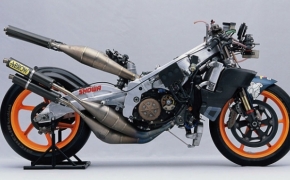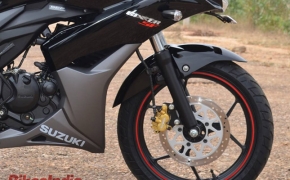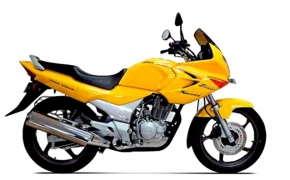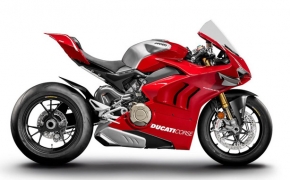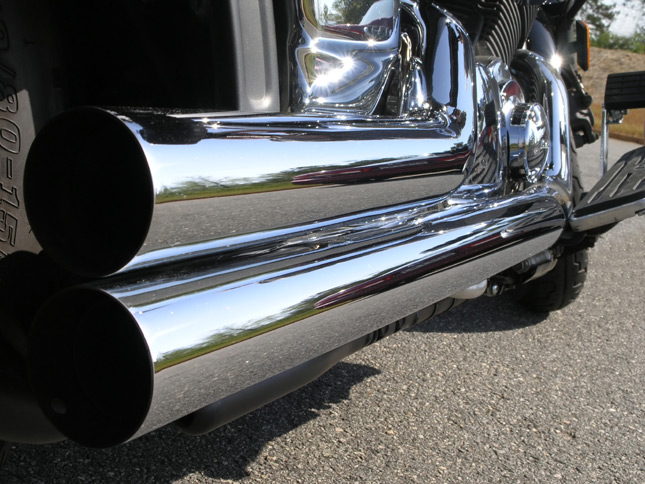 We see some bikes on the road totting a custom exhaust making a huge amount of noise when they go. These make you feel that the bike is making so much of power and the bike must be going so much faster than usual. But seriously, get this myth out of your head that a bigger sound from the exhaust means the bike is going faster. Yes, the exhaust systems do have an impact on the bike’s power and speed, but not as much as you feel or think. In face if some bike’s exhaust is making loads of sound, there is a bigger chance of the exhaust being broken than it making more power. But yes, bikes can make a bit more power by tuning the exhausts, and those are called free flow exhausts.
We see some bikes on the road totting a custom exhaust making a huge amount of noise when they go. These make you feel that the bike is making so much of power and the bike must be going so much faster than usual. But seriously, get this myth out of your head that a bigger sound from the exhaust means the bike is going faster. Yes, the exhaust systems do have an impact on the bike’s power and speed, but not as much as you feel or think. In face if some bike’s exhaust is making loads of sound, there is a bigger chance of the exhaust being broken than it making more power. But yes, bikes can make a bit more power by tuning the exhausts, and those are called free flow exhausts.Understand one thing clearly here, free flow exhaust do not act like rocket boosters or thrusters to propel your bike forward, so that is absolutely not how they work. There is an entirely different mechanism that goes into it. If you take an average regular stock exhaust, you will find that it has certain components to it. At the beginning of it is the Header which is the one in contact with the combustion chamber and the exit valves. The header has a bend on it to allow the exhaust gases move out in the direction they are meant to move out.
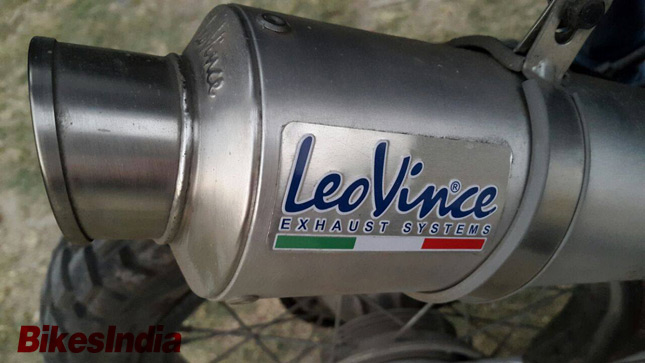 After the header comes the Catalytic Converter. This is one of the most important parts of the exhaust from the environment point of view. The exhaust fumes that come out contain a lot of impurities and harmful gases. The catalytic converter converts these gases into a bit less environment harming and hence your PUC levels in check. After the catalytic converter comes the manifold which is generally a long pipe which carries the exhaust fumes outwards towards the final end of the exhaust which is the muffler. The muffler is actually the one which reduces the sound but it just does not absorb or make the noise disappear.
After the header comes the Catalytic Converter. This is one of the most important parts of the exhaust from the environment point of view. The exhaust fumes that come out contain a lot of impurities and harmful gases. The catalytic converter converts these gases into a bit less environment harming and hence your PUC levels in check. After the catalytic converter comes the manifold which is generally a long pipe which carries the exhaust fumes outwards towards the final end of the exhaust which is the muffler. The muffler is actually the one which reduces the sound but it just does not absorb or make the noise disappear.
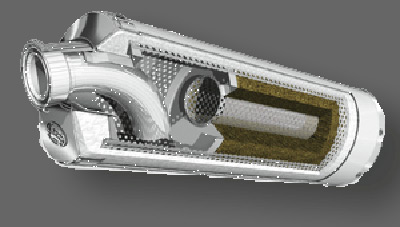 The muffler actually is a bigger pipe covering the smaller inner exhaust pipe. The inner pipe has a lot of tiny holes in it which lets the noise escape and the noise waves bounce back from the outside wall and collide with the other out coming waves causing them to negate each other. This creates a loss in the noise and hence the muffled effect or the silencer functioning. Also this is exactly what gives the bike’s exhaust the noise that it gets. So if the bike’s noise beat needs changing the muffler or the holes need changing and this will result in a different sound.
The muffler actually is a bigger pipe covering the smaller inner exhaust pipe. The inner pipe has a lot of tiny holes in it which lets the noise escape and the noise waves bounce back from the outside wall and collide with the other out coming waves causing them to negate each other. This creates a loss in the noise and hence the muffled effect or the silencer functioning. Also this is exactly what gives the bike’s exhaust the noise that it gets. So if the bike’s noise beat needs changing the muffler or the holes need changing and this will result in a different sound.This exactly the reason why some custom exhausts make a lot of noise, because the muffler is completely removed, hence the entire sound made in the combustion chamber comes out just as is. One of the best examples to give here is Royal Enfield bikes with the clear exhaust making an ear-splitting noise.
 So finally coming to free flow exhaust, the reason to cover all this was to make sure there are no myths and misunderstandings in the mind of the readers as to how the stock exhaust is and how the free flow exhaust is different. Now we saw the components present in the exhaust, so with free flow, as the name suggests, there are no components in between. The exhaust fumes exit the combustion chamber and head straight out without going through anything else and hence causing the huge amount of noise.
So finally coming to free flow exhaust, the reason to cover all this was to make sure there are no myths and misunderstandings in the mind of the readers as to how the stock exhaust is and how the free flow exhaust is different. Now we saw the components present in the exhaust, so with free flow, as the name suggests, there are no components in between. The exhaust fumes exit the combustion chamber and head straight out without going through anything else and hence causing the huge amount of noise.But the main impact that free flow exhaust causes on the performance is variable. In case of carbureted engines, the increase in performance is negligible, but one can expect a slight increase in the efficiency. This is because due to the exhaust outflow of gases, there is a bit of back pressure that is caused. But the outward momentum of the gases is enough to exit out and hence this creates a vacuum inside that cause the next batch of air to be sucked out to fill in the void. So when the gases exit from one end, there will definitely be some extra demand for air intake as well. This causes the air sucking action of the carburetor to work a little overtime and hence there is more air available for the fuel to burn which results in more efficient combustion and hence a small rise in fuel efficiency as well.
The reason there is no increase in power output is because there carburetor has a certain jetting of fuel set through its diaphragm. This does not allow excess fuel to pass through causing no increase in the fuel flow. Hence the power generated is no different than any other way. So there is the only ever so slight increase in power because of the free flow exhaust back-pressure and nothing else. If one really wants to increase the performance in this case, then he/she will have to get the carb up-jetted.
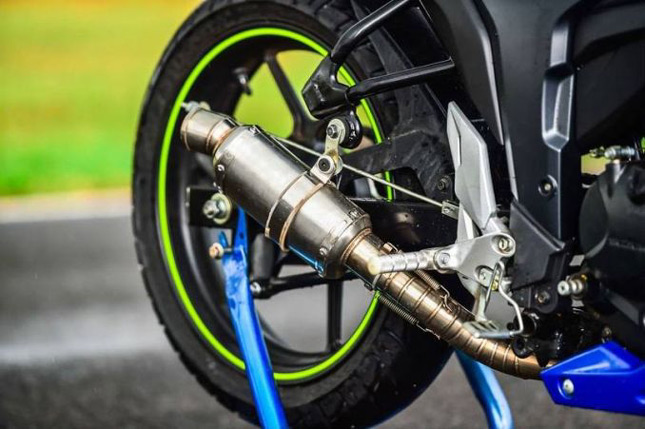 This though is not the case with FI engines. Fuel Injection is controlled by the ECU by measuring the air inflow through the sensor. So when due to the Free Flow Exhaust, the air intake increases, the ECU regulates the fuel injection rate as well accordingly depending on the air flow sensor reading to keep up with the constant air-fuel mixture rate. This extra fuel when burns, creates the extra grunt and hence the resulting increase in performance. But it simple engine performance and tuning that takes the toss and no black magic on the increase of performance. But then it also means the ever so loss on efficiency due to the excess fuel being burnt. Also with the sound from the exhaust being such a music to many, people prefer riding the bike fast and not sanely causing further decrease in the efficiency.
This though is not the case with FI engines. Fuel Injection is controlled by the ECU by measuring the air inflow through the sensor. So when due to the Free Flow Exhaust, the air intake increases, the ECU regulates the fuel injection rate as well accordingly depending on the air flow sensor reading to keep up with the constant air-fuel mixture rate. This extra fuel when burns, creates the extra grunt and hence the resulting increase in performance. But it simple engine performance and tuning that takes the toss and no black magic on the increase of performance. But then it also means the ever so loss on efficiency due to the excess fuel being burnt. Also with the sound from the exhaust being such a music to many, people prefer riding the bike fast and not sanely causing further decrease in the efficiency.
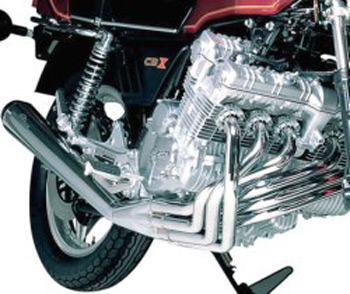 All this is fine in case of a single cylinder engine, but if this was the case in a multi-cylinder engine like in sports bikes and power cruisers, then in this case the exhaust pipes if they have their own individual cylinders to attend to, do not cause issues. But if the pipes funnel from multi to one; then in this case the pressure build up can be massive causing way too much back pressure and this could be harmful to the engine. Hence the piped in such case have to be tuned and bent and adjusted so that the exhaust from each cylinder should follow the other so that there is no overlapping and hence causing issues. This could get really dangerous in case of free flow exhausts.
All this is fine in case of a single cylinder engine, but if this was the case in a multi-cylinder engine like in sports bikes and power cruisers, then in this case the exhaust pipes if they have their own individual cylinders to attend to, do not cause issues. But if the pipes funnel from multi to one; then in this case the pressure build up can be massive causing way too much back pressure and this could be harmful to the engine. Hence the piped in such case have to be tuned and bent and adjusted so that the exhaust from each cylinder should follow the other so that there is no overlapping and hence causing issues. This could get really dangerous in case of free flow exhausts.So all in all, free flow exhausts do have their advantages and disadvantages, but then with it, you have to very well be prepared to have your PUC levels go for a toss. Also not to forget, the Free Flow exhausts are also available in stock noise or low noise muffled versions, so if you want to go for a Free Flow exhaust and do not want the extra unwanted sound, then even you got a choice here.
By: Pratik Patole












